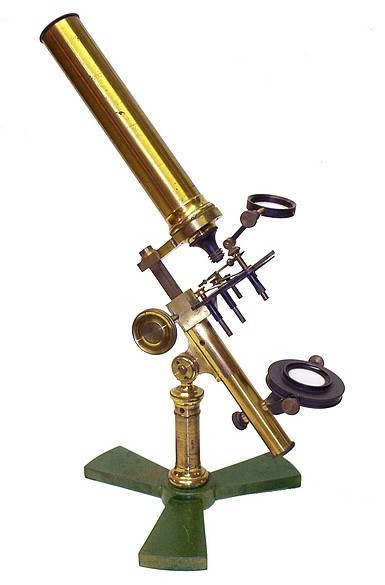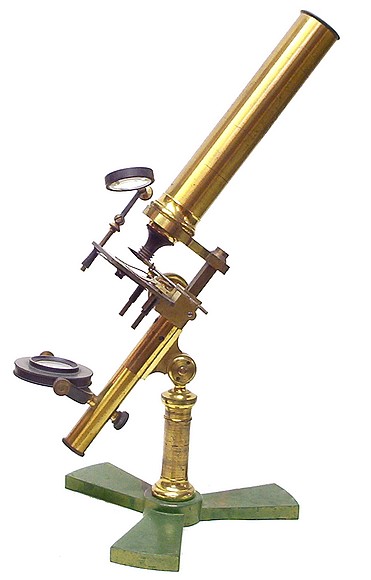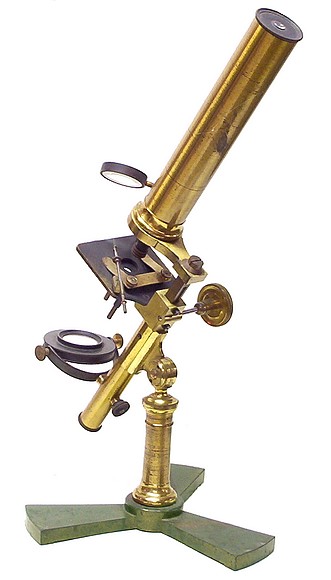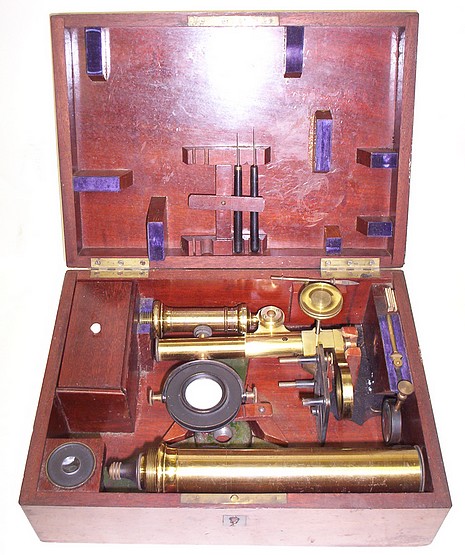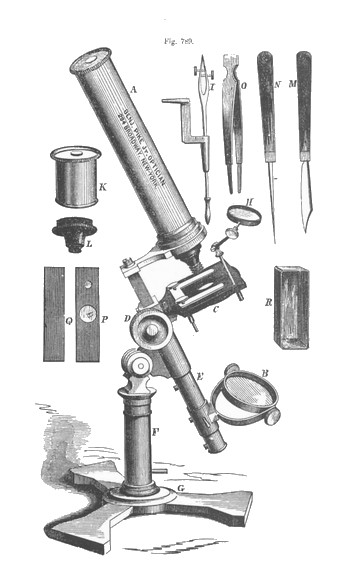From:Pike's Descriptive Catalogue of Optical, Mathematical, and Philosophical Instruments, Vol. I, 1856
Description.-To
a heavy tripod base is screwed a brass pillar with
a cradle-joint at the top; from the moveable part
of the joint an arm or cross-piece extends,
carrying a circular column, to which is attached
the stage, or part on which objects are placed for
examination, which is a large flat plate, having a
central opening, over which the sliders containing
objects for examination are placed; small spring
clips moveable up and down in sockets in the stage
may be pressed over the slider to secure it from
falling, when the instrument is used in an inclined
or horizontal position; beneath the stage-plate is
the diaphragm, which is a plate of brass perforated
with four or more holes of different sizes; this
revolves on a pivot so as to bring each hole in
succession under the object-glass, and is used in
modifying the light in examining minute transparent
objects. There is a hole in the stage-plate for
receiving the spring forceps, and a socket for the
condenser. The mirror consists of a circular brass
frame, in which are set two silvered glasses, one
concave and the other plane, and two inches in
diameter; the former reflects the light in
converging, and the latter in parallel rays; for
facility of adjustment the frame carrying the
glasses is made to turn in every direction, by
means of joints, and adapted to a tube fitting the
brass column, which may be slid either up or down
by pressing two small handles projecting from the
sides; by this movement, the rays reflected from
the concave mirror may be brought to a focus or
not, as required upon any given object on the
stage. The compound body is a tube of brass about
seven inches long, and one and a quarter inches
diameter. It contains the eye-piece at the upper
end, and the object-glasses at the other, screwed
to an arm having a square bar which is fitted to
move by tooth and pinion motion within the round
brass column; to its upper end the eye-pieces are
adapted, to its lower the object-glasses. As the
latter are of different magnifying powers, and also
the objects to be examined rarely of the same
thickness, it is required that there should be a
focal adjustment; this is effected by a tooth and
pinion arrangement in connection with the square
bar sliding within the round column E, and motion
given by turning the milled head, D, by which the
whole tube carrying the eye-piece and
object-glasses is made to approach or recede from
the object. The eye-piece consists of two
plano-convex lenses; the smaller one is called the
eye-glass, and the larger the field-glass; they are
set in brass cells, and mounted in a tube whose
length is about equal to half of the sum of their
focus. Between the lenses is placed a stop, or
diaphragm, for diminishing the spherical
abberration. The inside of these tubes, and also of
all other parts through which the light passes, is
blackened, so that no other rays than those from
the mirror should interfere with the illumination.
The achromatic object-glasses are three in number,
and screw together, being so arranged that one,
two, or three may be used according to the
magnifying power required. There is also a double
convex lens in a cell, useful where a low power is
required. The condenser, H, or illuminating lens
for opaque objects, is a plano-convex lens of short
focus set in a brass frame, and supported by one of
its arms in a socket attached to the stage-plate;
the arms are jointed, and the lens may be set in
any position required to receive the light and
condense it on the object to be examined. The steel
forceps, I, for holding small objects, are formed
at the end of a small wire, and made to slide in a
small tube having a pin projecting to fix it in a
hole in the stage; the forceps are opened by
pressing small studs between the thumb and finger.
The dissecting-knife, M, and point, N, are
convenient for separating parts of objects, and the
brass forceps, O, for taking up small objects. The
fluid-box, R, is of brass, with a glass bottom, and
used for containing any liquid to be examined.
Several test-objects, P, and glass sliders are sent
with the microscope. This instrument in the
vertical position is from fourteen to fifteen
inches high; but the parts are made to separate in
an easy manner by screws, and every part neatly and
securely packed in a mahogany box with lock and
key, the blocks supporting the parts being lined
with velvet, and the box, inside and outside, well
polished; size of box, ten inches long by eight
wide, and three and a half deep. Price $40
Although microscopes
of this type are usually unsigned by the French maker, they are
commonly attributed to the workshop of Charles
Chevalier (1804-1859). Such microscopes were often imported into the USA and sold by American retailers such as Benjamin Pike Jr (see the above illustration taken from the Pike catalog).?
